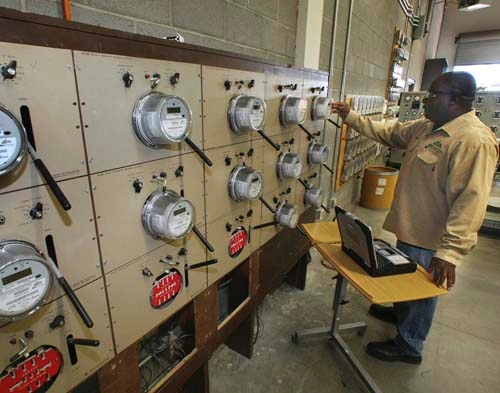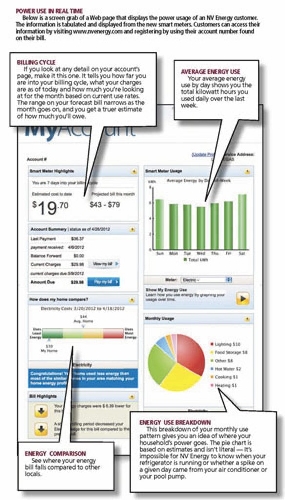Watching smart meter might be bright idea





You have more power over your electric bill than ever before, and you probably don’t even know it.
NV Energy is installing the last of its residential smart meters across Southern Nevada this spring, and that means almost every ratepayer in the area (save a few thousand opt-outs) can track their electric use online weekly, daily and even every 15 minutes. With the year’s hottest months ahead, you may soon be checking your consumption a lot, and that’s the idea, say NV Energy officials.
"This has been the whole vision of the smart grid for Nevada – to help customers take ownership of their energy use," said Gary Smith, the utility’s director of customer energy solutions. "It’s all about customer awareness that they have ownership of how much they use."
As of Wednesday, many Southern Nevadans hadn’t yet taken that ownership, even though doing so could save them 10 percent to 20 percent on their power bills, Smith said. NV Energy numbers show 56 percent of eligible ratepayers have registered to see their use patterns, but only 19.4 percent check their consumption dashboard every month, and just 0.8 percent have clicked through to look at detailed data. The utility wants to get more ratepayers to monitor consumption and maybe cut back a bit.
"It’s pretty darned expensive to produce this energy, particularly during peak times," Smith said. "If customers conserve, we don’t have to spend as much building power plants or making other capital investments."
So how does it work?
Once you’ve had your smart meter for 45 days and you’ve set up an online account, you can sign in and immediately see your power use. On the upper left of the screen is a box showing how far you are into your billing cycle and how much you’ve already spent. It also estimates your bill based on current use.
To the right is a graph displaying your daily average energy use for the last week.
Below that is a link to a page with your energy use, and that’s where things get interesting. You can chart your daily power use over the last month or billing cycle and measure daily power use against temperatures. You can look at average use by day of the week, and, perhaps most revealing, look at power use in 15-minute intervals through the previous day.
Those quarter-hour increments, which show power spikes and dips, are where many ratepayers find savings, Smith said.
The utility doesn’t know how you’re using energy, but a little investigative work can tell you what’s causing surges in use. For example, Smith determined that his three sons’ long, hot showers kept his electric water heater at a constant hum in the mornings. So he turned down the heater’s temperature, installed a low-flow shower head and dropped his power use by 17 percent in one month. Smith said his kids have even jumped into the game, unplugging video-game players and flat-screen televisions and checking the household graph to see if use budged.
In another case, a vacation-home owner wrote to complain about higher rates since his smart-meter installation. The company walked the homeowner through his energy use and found his programmable thermostat was set to run the air-conditioning nonstop all weekend. A quick adjustment changed that.
And more than a few homeowners are shocked to see how much their pool pump boosts their power bill, Smith said.
"The best use is in being able to see the costs," Smith said. "For instance, I know that on average I’m using $5 a day, or the same amount as a venti coffee at Starbucks, but I know I want to get down to a grande. I’m trying to find ways to do that. It’s not just a bill you get once a month in the mail. It’s a chance to really understand how you use energy."
Even if you think there’s little you can do to change your power use, it’s good to at least know how much you’re spending before you get sticker shock from your monthly bill, Smith added.
Through the website, consumers can sign up for email alerts on their bill either weekly or when they’ve hit a certain dollar threshold.
Industry experts say there’s a place for such technology.
Robert Boehm, director of the Energy Research Center at the University of Nevada, Las Vegas, guided and researched power-use cues at Villa Trieste, an experimental Pulte Homes community in Summerlin. Boehm said he’s still studying how Villa Trieste’s in-home energy displays affected consumption. In general, though, programs that require ratepayers to actively check them tend to attract "only the really enthusiastic people," Boehm said.
Still, Boehm said Villa Trieste homeowners who followed energy use and changed their habits saw bills drop to practically nothing (the community’s homes are also designed to the energy-efficiency standards of the U.S. Green Building Council’s Leadership in Energy and Environmental Design program).
"These types of programs are absolutely necessary for the country as a whole, and particularly for the desert Southwest," Boehm said. "We have such exaggerated peak use in the summer here, and we really need to address it. You can build new power plants to address the peak, but that’s a waste of money because you don’t use peak plants all the time."
NV Energy is looking for ways to make usage data even more available to ratepayers. For people without computers, it’s working on a phone-in system. It’s also developing an application that would send text messages on electric costs straight to ratepayers’ cell phones, though the company doesn’t know when the service might be available.
"We haven’t gone far enough yet. It shouldn’t be this mechanical," Smith said. "Once we get it directly into people’s hands, it’s right there, and they have access to it instantly."
Contact reporter Jennifer Robison at jrobison@reviewjournal.com or 702-380-4512. Follow @J_Robison1 on Twitter.












